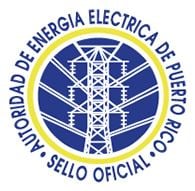Jurisdiction executive branch Website www.aeepr.com Founded 2 May 1941 | Key document Law No. 83 of 1941 | |
 | ||
Formed May 2, 1941; 75 years ago (1941-05-02) Agency executive Vacant, Executive Director Profiles | ||
The Puerto Rico Electric Power Authority (PREPA) —Spanish: Autoridad de Energía Eléctrica (AEE)— is an electric power company and the government-owned corporation of Puerto Rico responsible for electricity generation, power transmission and power distribution in Puerto Rico. PREPA is the only entity authorized to conduct such business in Puerto Rico, effectively making it a government monopoly. The authority is ruled by a board of directors appointed by the governor with the advice and consent of the Senate.
Contents
History
PREPA was originally named the Puerto Rico Water Resources Authority (PRWRA) —Spanish: Autoridad de las Fuentes Fluviales (AFF)— which was created by Law No. 83 of May 2, 1941 during the governorship of Rexford G. Tugwell. Government-owned, PRWRA unified diverse regional and local electric power companies into one unified electric grid.
Board of directors
The board of directors is the governing body of the Puerto Rico Electric Power Authority. Its membership usually consists of private citizens who are supposed to represent the public interest and may or may not include exofficio political officeholders (typically the Secretary of Economic Development and Commerce). This inconsistency happens as the board's structure changes whenever a political party gains power, usually every 4–8 years. Once both the governor and the legislature of Puerto Rico belong to the same party, one of the earliest laws amended is the one governing the authority in order to change the board's composition. Once the new board is settled in, one of the very first acts enacted by the new board is to appoint a new executive director. This constant back and forth effectively makes the authority a highly politicized tool rather than a resource for the people of Puerto Rico, and, consequently, changes the vision, strategy, and plans of the authority every 4–8 years according to the political party in power.
Of the different members of the board, the governor is usually required to appoint four members with the advice and consent of the Senate. It is through these members, along with the incumbent political officeholders which serve as exofficio, the way in which the governor and the political party in power effectively control the authority. Three additional members of the board are directly elected by consumers by plurality-at-large; two of them by residential consumers and one by commercial ones.
The last structural change to the board occurred on June 25, 2013 after governor Alejandro García Padilla enacted Act 29 of 2013 together with the 17th Legislative Assembly. The act effectively replaced the incumbent board with an entirely new board, as follows:
Power plants
PREPA serves close to 1.5 million customers through several power plants:
Puerto Rico has 21 hydroelectric plants rated at a combined 156MW.
Subsidiaries
The public corporation also provides fiber optic broadband to private carriers through one of its subsidiary, PREPA Networks. PREPA is also studying the possibility of selling energy to the United States Virgin Islands with the installation of an underwater power cable between Fajardo and the island of St. Thomas—similar to the power cable with which it services its clients in Vieques and Culebra, which are also islands.
Labor unions
There are four labor unions that represent the workers from the authority exclusively UTIER, UITICE, UEPI, and UPAEE.
Finances
As of 2014 the authority carries liabilities of $10.1 billion USD against assets of $6 billion. It also operates with a deficit of about $354 million against revenues of $4.8 billion. In terms of costs, $2.6 billion or about 58% of PREPA's expenses are attributed to fuel purchases alone while salaries and collective bargains represent less than 13% of the authority's expenses.
On May 23, 2014, Citigroup severely curtailed PREPA's line of credit for fuel purchase, forcing PREPA to run out of cash to pay Petrobras, its main oil supplier. Petrobras, in turn, threatened to cut off further shipments to the authority. This forced the authority to take $100 million out of its Capital Improvements Fund in order to pay its debt to Petrobras. PREPA argues that the different agencies of the government of Puerto Rico owe them more than $290 million in debt, while an additional $375 million of revenue is lost through subsidies enacted by the Puerto Rican legislature. An additional $600 million is owed to the authority by residential and commercial consumers, some of them by consumers living in public housing. The authority argues that it wouldn't have a problem being self-sufficient if it were paid the aforementioned debt and if it weren't forced to give out subsidies. On June 3, 2014, senator Ramón Luis Nieves admitted publicly that, "part of the financial problem at PREPA was provoked by the government and the Puerto Rican legislature."
On June 11, 2014, Fitch Ratings downgraded its rating on the authority's to speculative non-investment grade ("junk status") from BB+ to BB while putting the authority on negative rating watch.
